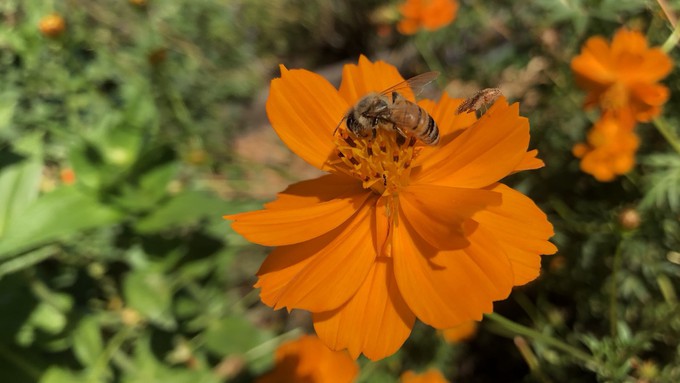
Killer heat scorches Labor Day weekend; plan accordingly

A honey bee gets its work in early, collecting pollen from the Diablo cosmos flower on what will be another hot day. Kathy Morrison
Don’t let slightly cooler temperatures on Friday and Saturday fool you; this heat wave hasn’t hit its peak.
According to the National Weather Service, conditions for the next four days will be downright “dangerous.” An “extreme heat warning” is in effect for the Sacramento Valley and Sierra foothills from 11 a.m. Sunday through 8 p.m. Wednesday. A high of 115 degrees – which would be an all-time high for Sacramento – is possible.
“Very high risk of heat stress or illnesses for the entire population,” the weather service said Saturday. “Stay hydrated. Avoid being outdoors in the sun 10 a.m. to 6 p.m. … Stay in a cool place especially during the heat of the day.”
Those conditions are unsafe for animals of all kinds; keep pets indoors, too.
As for your garden, the best plan is to water early and deeply. Give plants the moisture they need to cope with this high heat. Container plantings are especially at risk; move pots to shady areas if possible.
With this heat also comes high fire danger. Do not use power tools or anything that could cause a spark to fly.
How hot can it get? The weather service predicts 112 degrees for Monday and Tuesday in Downtown Sacramento, although that could creep higher. Little relief will come after dark with overnight lows forecast in the mid 70s.
Temperature records likely will be set. Before this week, Sacramento’s hottest September day on record: 109 degrees.
Triple-digit highs will continue through Thursday before finally “cooling” to a mere 98 degrees Friday, says the weather service.
During this heat spell, take it easy outdoors and plan for cooler days ahead – like next week. The long-range forecast calls for low 90s by next Saturday and Sunday.
This week in the garden:
* Harvest tomatoes, peppers, squash, melons and eggplant. In this heat, pick sooner than later; they can turn overripe in a hurry.
* Compost annuals and vegetable crops that have finished producing.
* Deep-water shrubs and trees. Be on the lookout for plants stressed by this heat.
* In the morning, give plants a shower – especially if you see signs of spider mites. Take a hose and blast their webs off vines and bushes.
* Watch out for tomato hornworms. They love this heat, too.
* Indoors, start seedlings for fall vegetable planting, including bunching onion, cabbage, broccoli, cauliflower, kale, radicchio and lettuce.
* Sow seeds of perennials in pots for fall planting including yarrow, coneflower and salvia.
* One good thing about hot days: Most lawns stop growing when temperatures top 95 degrees. Keep mower blades set on high.
Comments
0 comments have been posted.Sacramento Digs Gardening to your inbox.
Sites We Like
Garden Checklist for week of July 21
Your garden needs you!
* Keep your vegetable garden watered, mulched and weeded. Water before 8 a.m. to reduce the chance of fungal infection and to conserve moisture.
* Feed vegetable plants bone meal, rock phosphate or other fertilizers high in phosphate to stimulate more blooms and fruiting. (But wait until daily high temperatures drop out of the 100s.)
* Don’t let tomatoes wilt or dry out completely. Give tomatoes a deep watering two to three times a week.
* Harvest vegetables promptly to encourage plants to produce more. Squash especially tends to grow rapidly in hot weather. Keep an eye on zucchini.
* Pinch back chrysanthemums for bushy plants and more flowers in September.
* Remove spent flowers from roses, daylilies and other bloomers as they finish flowering.
* Pinch off blooms from basil so the plant will grow more leaves.
* Cut back lavender after flowering to promote a second bloom.
* It's not too late to add a splash of color. Plant petunias, snapdragons, zinnias and marigolds.
* From seed, plant corn, pumpkins, radishes, winter squash and sunflowers.